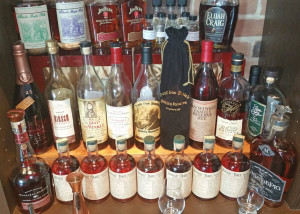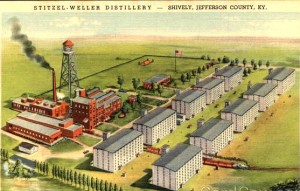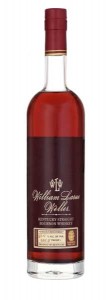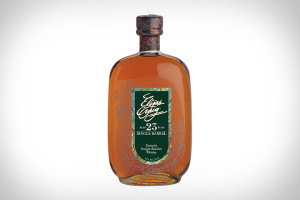By Richard Thomas
For whiskey fans in the United States, the coming of autumn means the season of release for all the big annual limited edition bourbons, and foremost among them is Pappy Van Winkle. The phones at liquor stores start ringing about getting on waiting lists, signing up for lotteries, or just how much one has to pay for the illustrious bourbon whose surging prices are placing it in the same category as rarefied single malt Scotches. The mainstream media begins to post more articles and 30-second TV stories about Van Winkle bourbon, and whiskey forums begin to burn with talk about those things named “Pappy.” Sometimes there are even heated, ugly scenes at liquor stores, made by frustrated people who can’t get a Van Winkle fix.
In short, ’tis the season for Pappy Fever.
These days I tend to use Pappy Fever as one of my yard sticks for rating the quality and maturity of a bourbon enthusiast, since anyone who still catches Pappy Fever is either prone to obsessive behavior or doesn’t care enough about bourbon to find better, cheaper and/or more readily available alternatives. I wrote off ever buying another bottle of Pappy Van Winkle myself years ago, and have long since moved on.
So, if you or a friend have been afflicted with Pappy Fever, here is how you beat that bug once and for all:
Step 1: Realize What Is Actually In That Bottle
Back in the pre-fever days, when you could still pay recommended retail prices for Pappy Van Winkle and acquire a bottle just by signing up on a waiting list, the mystique for the bourbon brand was built up around its image as the heir of the defunct Stitzel-Weller Distillery. Yet even at that time, the liquid in those Van Winkle bottles was undergoing a transition, and that shift was defined by two important dates: 1992 and 2002.
Louisville, Kentucky’s famed Stitzel-Weller Distillery, once the home of the Van Winkle brand, shut its doors in 1992. Whiskey purchased by the Van Winkles from Stitzel-Weller continued to go into the bottles for many years after, but a simple exercise in math dictates that the very last of the original Stitzel-Weller bourbon stock should be going into this year’s batch of Pappy Van Winkle 23 Year Old. Younger Van Winkle expressions haven’t had bourbon from the original source in it for years now.
Or so conventional bourbon wisdom holds, but how true is that? The second date, 2002, marks when the Van Winkles formed their partnership with Buffalo Trace Distillery. That Frankfort-based distillery acquired their own stock of former Stitzel-Weller whiskeys at one point, as well as the wheated Bernheim Distillery-made bourbon (made between 1992 and 1999) that came with their acquisition of the Weller brand, plus having their own wheated bourbon stock dating back as far as the early 1990s. All of these stocks are rumored to have been used in Van Winkle whiskey at different times during the last dozen years.
Clouding matters further is speculation that any of the aforementioned stocks could have been transferred to the stainless steel, no-further-aging tanks that gained public attention in the Kentucky Bourbon Heist Case. Such tanks are known to have been used by Buffalo Trace to store their Eagle Rare 17 Year Old stocks until last year, but whether any of the Stitzel-Weller or Bernheim wheated bourbons were stored in this way is unknown. Finally, rumor has it that Ancient Age stocks, made with a high rye rather than a wheated mashbill, have been used at least once in Pappy 15 Year Old whiskey.
Just what exactly is in a given bottle of Pappy Van Winkle is far from clear these days, and in many ways the story of what might lurk in one of those elusive Van Winkle bottles offers real insight into what goes on behind the curtain in the whiskey industry. Still, one thing is certain: Pappy Van Winkle has changed over time and will continue to evolve. The brand offers great whiskey, but it is not a stable image of greatness, consistent and frozen in time.
Step 2: Don’t Obsess Over Weller Either
Josh Ozersky set off a major stir last year when he declared W.L. Weller 12 Year Old a reasonably priced substitute for Pappy Van Winkle. So high has the fever for Pappy risen that his article sparked a slew of copycats and a full-fledged run on Weller 12, causing the bourbon to evaporate from store shelves in a genuine media-driven shortage. The William Larue Weller that is part of the Buffalo Trace Antique Collection was driven to a peak price of just over $1,000 a bottle by this run, making it the most expensive whiskey of that grouping for a time. The bourbon has remained scare ever since, as have other expressions bearing the name Weller.
To his credit, Ozersky himself never said Weller 12 was simply a younger version of Pappy 15, although many of his copycats did and that false idea is what continues to fuel the subsidiary craze for all things Weller. Nowadays, Weller bourbon is made from Buffalo Trace stock, but it’s likely that only some of the Van Winkle bourbon might be. So stop obsessing about all things Weller, because doing so is as much about chasing a myth as obsessing about all things Van Winkle.
Step 3: Realize That Older Isn’t Necessarily Better
One of the key steps in becoming a knowledgeable whiskey enthusiast is knowing that older isn’t necessarily better, and being able to explain why and point to some younger whiskeys to prove it. The problem there is that even some people who know better still can’t let go of their obsession with a high age statement.
That age isn’t synonymous with quality is especially true when it comes to bourbon, which is aged in new white oak and therefore cannot routinely sit around for decades, like Scotch can, and remain drinkable. Depending on the distillery in question, bourbon generally hits its “sweet spot” after six to twelve years in the warehouse. Some people I know with some very well-developed palates dislike most bourbons older than that, finding them too woody. Indeed, to avoid becoming objectively too woody—too woody by anyone’s standards—aged bourbon demands cossetting. Buffalo Trace is rumored to have discarded a set of quarter-century old bourbon earlier this summer for just that reason: that it had gone way past the “sweet spot” and become too woody.
This notion applies to Pappy as well. For all the high prices commanded by the 23 Year Old, most experts prefer either the 20 or 15 Year Old. For my part, I usually rated the 20 Year Old as the best, followed by the 15 Year Old and placed the 23 Year Old in third.
A major part of the obsession with Pappy Van Winkle for those who have never heard of the names Stitzel or Weller is the age statement, because before the 21st Century there weren’t that many bourbons around with age statements of 15 years or greater. For those who obsess over age, Pappy was a brand that started at 15 years old, and that is a pretty big statement. Yet older doesn’t always mean better, and the Pappy Van Winkle line itself proves it.
Step 4: Consider The Other Bourbons Out There
OK, so you are probably unpersuaded by my urging to de-emphasize relying on age statements as a quality meter, and the other arguments have failed to cure your Pappy Fever. Try this dose of reality: without super connections or serious Benjamins to burn, you cannot find or afford a bottle of Pappy Van Winkle. Face facts, get over the fever, and move on to other bourbons!
Larceny: Like the Pappy you crave, this is a wheated bourbon. Like the original W.L. Wellers, this is made by Heaven Hill. Unlike either of those two, this bourbon comes in at the same level as beer and pizza money. Seriously, this is a real steal of a bourbon, one of the biggest bang for your buck bargains around. Buy it, try it, look at the cash that is still in your wallet, and feel that Pappy Fever abate.
Michter’s 10 Year Old: This choice isn’t as cheap as Larceny, but it’s the one that approaches the illustrious Pappies in terms of quality. I know more than a few folks in the whiskey hostings and tastings business that have told me about how Michter’s 10 Year Old often comes in on top of Pappy 15 Year Old in blind tastings. Even the croakers who hate Michter’s grudgingly admit to appreciating, perhaps even loving this bourbon. Although it costs $100, that is a fraction of what you’ll pay for even the cheapest Pappy, and it’s worth every penny.
Maker’s Mark 46: Here is an interesting idea: take Maker’s Mark, the world’s most popular wheated bourbon. Shove inserts of new French oak into the barrels late in the aging process, then make it a little older and a little stronger. French oak is noted for its spicy effects, and here it made Maker’s both spicer and sweeter. Try some the next time you feel Pappy Fever making you sweat.
And for those who are still unable to let go of big age numbers:
Elijah Craig 18 and 23 Year Old: These are released every year at the same time as Pappy Van Winkle, and match that line for age points. Because Elijah Craig doesn’t get nearly as much buzz as Van Winkle, they are much more easily had to boot. That isn’t to say you can just walk into a liquor store and buy one, because it’s usually not quite that simple, and you should expect to drop two or three hundred dollars. Basically, getting old Elijah Craig is like what getting Pappy was like several years ago.
 The Whiskey Reviewer A World of Whiskey, Poured Every Weekday
The Whiskey Reviewer A World of Whiskey, Poured Every Weekday





BTW, ever since I first heard that Eagle Rare 17 was coming out of a stainless steel “cold storage” tank, I have wondered about what else Buffalo Trace might be doing the same thing with. Then came the Pappygate thing you mentioned, so thanks for bringing up the questions and rumors. It doesn’t get raised enough, and it’s certainly a factor.
Stuff like this is why you have become my favorite website for whiskey. It says things nobody else can or will, but it’s done as real news and not like some blogger who might have just pulled it out his butt.
But I need my Pappy Van Winkle 15 Year Old! 😉
Not sure where I heard it or to its validity, but I do remember seeing a mention some time ago about Van Winkle Family Reserve Rye coming out of stainless tanks at Buffalo Trace. Not sure if this is still the case.
I have been fortunate to try 10 yr old pappy and 15 , and I agree with your statement that older doesn’t always mean better . I much prefer the 10 than the 15. Anyway, since I found your web page it’s certainly my go to for insight from the bourbon whisperer. Keep up the good work and I look forward gleaning more knowledge. My next quest is to find Michters 10.